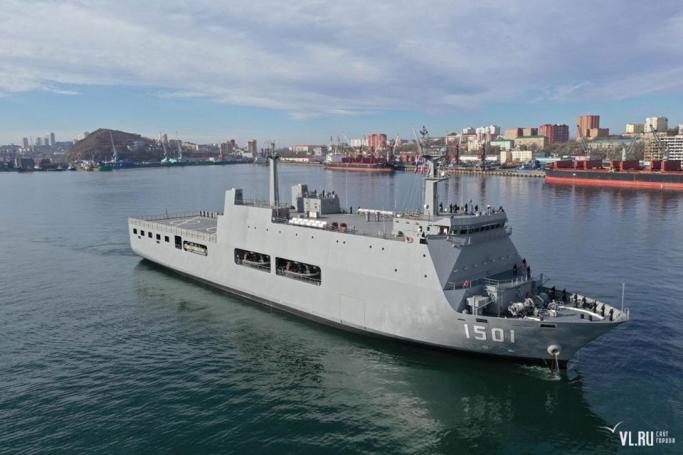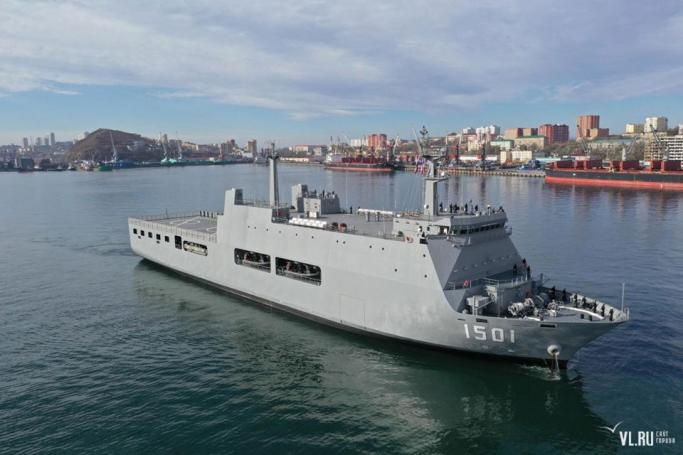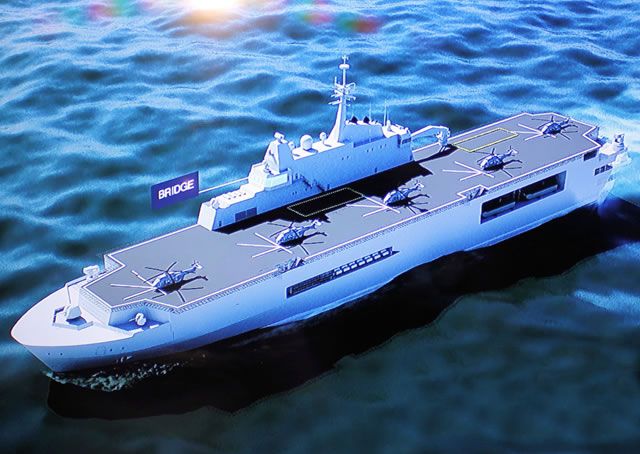From a LSL to a LPD and the larger LHD, or LHA, ship to shore transfer is becoming a more vital role for the navy's around the world. Not just for moving military equipment but also in humanitarian aid and HADR. These specialised vessels have the command spaces, and communications, as well as operating theatres and hospital wards.
Most can also move a large number of troops which in an evacuation situation means the beds are there. Depending on how far they need to be evacuated, many more can be transported using the vehicle deck space. HMNZS Canterbury did this during the Kaikoura Earthquake in 2016.
So this space can be used to accommodate refugees and casualties, as well as field hospitals and military headquarters. Secondly, such vessels provide a platform to move personnel and equipment rapidly en-masse from beyond the horizon to the shore.
A lack of shore facilities and ports present few problems for both landing craft and amphibious support ships as they are designed to operate with austere facilities and can often disgorge their cargoes without any shore assistance. Despite their utility, modernization efforts for these vessels are following a halting and piecemeal path in the Asia-Pacific region; several navies continuing to operate aging vessels while a few are now replacing them with modern LPD's.
Australia
- x2 Canberra class LHD
- x1 Bay Class LSD.
Australia, is performing an important expansion of its amphibious capabilities in the form of the two ‘Canberra’ class Landing Helicopter Docks (LHDs) which it is acquiring from Spanish shipbuilder Navantia. Both of these vessels are now commissioned into the Royal Australian Navy (RAN). When fully-loaded the ‘Canberra’ class ships displace 27,851 tonnes. They can achieve a top speed 20.5 knots and accommodate up to four Landing Craft Air-Cushioned (LCAC) vehicles in their dock plus up to 24 helicopters. The RAN design includes a ski-jump augmenting the flight deck to allow the operation of Lockheed Martin F-35B Lightning-II Joint Strike Fighter Short Take-Off/Vertical Landing combat aircraft in the future.
It almost goes without saying that the acquisition of these ships represents a major improvement in the RAN’s capabilities allowing the country to not only project power a significant distance beyond its borders, but to perform a commanding role in military operations other than war; notably the provision of humanitarian assistance in the wake of natural disasters.
Once underway, these ships can sustain themselves at sea for up to 50 days before they require replenishment. The space which these ships accommodate provides 830 lane metres for heavy and light vehicles and room for over 1,000 troops. The advent of the ‘Canberra’ class is occurring alongside the supply of twelve LCM-1E fast landing craft from Navantia. These vessels will replace the RAN’s existing amphibious support ships which includes six ‘Balikpapan’ class Heavy Landing Craft (LCH), and single ‘Tobruk’ class Heavy Landing Ship (LSH).

Burma
- Makassar class LPD
In 2019, South Korea company, Dae Sun Shipbuilding launched Myanmar Navy LPD named UMS Moattama. It's reported that Myanmar Navy ordered this ship in 2018 from South Korea. The Moattama is designed for amphibious operations, transportation of personnel as well as disaster relief and humanitarian assistance. It has a well-deck and two helicopter spots + hangar.
http://mizzima.com/article/myanmar-navys-new-lpd-arrives-vladivostok



Indonesia
- Makassar class LPD
Indonesia signed a US$150 million contract in December 2004 and the first two units were built in Busan, South Korea. The remaining two were built at Indonesia's PT PAL shipyard in Surabaya with assistance from Daesun. The contract for the 3rd and 4th LPD to be built in Indonesia was signed with PT PAL on March 28, 2005.
On 19 October 2006, the first of the two Indonesian-built units, was laid down in a ceremony by Admiral Slamet Subiyanto, Chief of Staff, Indonesian Navy. The 3rd and 4th units had been designed to function as flagships with provisions for a command and control system, 57mm gun and air defense systems.
The 5th ship ordered by the Indonesian navy on January 11, 2017. The first steel cutting ceremony for said ship was conducted on April 28, 2017. The ship's keel was laid on August 28. 2017
Malaysia
RMN has an outstanding requirement for a Multi-Role Support Ship (MRSS) to replace the KD Inderapura. The MRSS was to be included in the Ninth Malaysian Plan but was postponed due the financial crisis of 2008.
New Zealand
- HMNZS Canterbury. (MRV)
HMNZS Canterbury is a multi-role vessel (MRV) of the Royal New Zealand Navy. She was commissioned in June 2007. She carries two LCM and can carry troops and equipment. She had a rough start but is proving her worth in the RNZN and has part of AU-NZ disaster relief response force.
She has proved herself in the Christchurch earthquake, 2011, and the Kaikoura earthquake 2016, she has done many HADR operations around the pacific, from Fiji, Samoa and Tonga, including "The Pacific Partnership Program" with the USN, and RAN.
Canterbury has been involved in many exercises including RimPac, Southern Katipo, Talisman Saber, and various other exercises, she has been a very busy ship. She has a five-bed hospital ward, a two-bed sickbay, an operating theatre, a medical laboratory, as well as a morgue.
- Options for the NZDF and RNZN 2nd enhanced Sealift vessel
- Why do I think the Endurance 170 LHD is a good choice for the RNZN.
In 2019 the Defence Capability Plan states and calls for a seconded enhanced sealift vessel. "An example of the class of vessel that could be considered under this project is a Landing Platform Dock." This does not mean that a LPD is what they go (although to be fair and honest this is most likely what is truly sort after) for as there are many options from smaller LHD and LHA like the Endurance 170 all would be in the Budget of more than $1B+
This enhanced sealift ship is not to replace HMNZS Canterbury but compliment and when Canterbury retires in 2035, a second enhanced sealift ship is to be bought maintaining a fleet of two enhanced sealift vessels. These new vessels will definitely enhance New Zealand's amphibious and force projection capabilities.


Philippines
- Makassar class LPD
The Philippine Navy selected a variant of the Makassar class design from PT PAL, called the Tarlac-class for its Strategic Sealift Vessel (SSV) program following competitive bidding in 2013, and the contract for two units was signed on 23 January 2014. The first unit was laid down at Surabaya on 22 January 2015.
Singapore
- Endurance class LPD
Interestingly, despite the size of the nation, the Republic of Singapore Navy retains a formidable amphibious force. The largest combatants in this respect are the four ’Endurance’ class LPDs which are the largest surface combatants in the fleet. When fully loaded, these ships displace 8,500 tonnes and can reach a speed in excess of 15 knots. Four landing craft can be carried on davits with the ship able to accommodate up to 18 tanks, 20 vehicles plus cargo and 500 troops. On the flight deck, helicopters of Boeing CH-47F Chinook size can be comfortably accommodated with the hangar able to house up to two medium-lift utility helicopters.
The ‘Endurance’ class vessels are complemented by six LCMs and 30 LCUs.

Singapore has also indicated that it wants to expand its amphibious capabilities, with a couple of smaller LHD’s like the Endurance 170 LHA. These will definitely enhance Singapore amphibious and force projection capabilities.

- Options for the NZDF and RNZN 2nd enhanced Sealift vessel
- Why do I think the Endurance 170 LHD is a good choice for the RNZN.
Thailand
- Endurance Class LPD
On 11 November 2008, a SGD 200 million contract was signed between ST Marine and Thailand for the sale of one unit of the Endurance-class LPD and its associated landing craft. The LPD would use the Terma C-Series system, which includes the C-Flex combat management system, C-Search radar suite which includes the Scanter 4100 radar and IFF, and the C-Fire fire control system.
On 21 March 2011, the new ship was christened HTMS Angthong (pennant number LPD-791) and was launched from ST Marine's dockyard by the wife of Admiral Khamthorn Pumhiran, Commander-In-Chief of Royal Thai Navy (RTN). The delivery of the ship was completed on 19 April 2012

Vietnam
- HQ-521, newest landing craft of the Vietnamese Navy
Similarly, over the long term, the Vietnamese Navy may choose to enhance its amphibious capabilities. The fleet includes three ex-Russian ‘Polnocny’ class landing vessels, and a total of six ex-US Navy LSTs and LSMs which are reinforced with a total of 24 LCM and LCUs, also drawn from ex-US Navy stocks.
Apart from a few notable exceptions such as the RAN’s acquisition of its ‘Canberra’ class LHD ships, the market for amphibious support vessels and landing craft in the Asia-Pacific region was largely stagnant. This appears to be slowly changing, with many countries buying the Makassar class LPD and Endurance Class LPD.
In June 2019 New Zealand announced it's Defence Capability Plan which states wanting a second enhanced amphibious sealift vessel and keeping an operational squadron of a two-ship enhanced sealift fleet. The 2nd vessel to enter service around 2028/9 and the second enhanced vessel to replace HMNZS Canterbury round 2035. Singapore also wanting a "Joint Multi Mission Ship" or JMMS the Pacific region is slowly changing.






